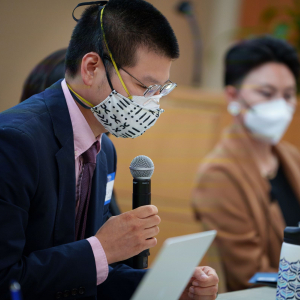
Observations from an Asian American & Diaspora Studies Program Student
Photos by John West, Trinity Communications
It’s easy to let something momentous wash soundlessly into a current of small logistics: the shoes that tape won’t hold, the baby quiet in a corner, the caterers folding black tablecloths and the blue folders waiting to be filled. Still, it was impossible to miss the waves of newness at the inaugural Southeast Conference on Asian American Studies – the first conference centered on Asian American Studies (AAS) in the U.S. South. Even though geographic categorizations are largely arbitrary. Even though what “Asian American Studies” means is constantly in flux.

The conference opened on Friday, Sept. 9 with a keynote address given by Sylvia Chong (University of Virginia), who eight years ago conducted an external review for Asian American Studies at Duke. She wove through the distortions of history which make possible an Asian male victimhood, the gravity of enmeshed identity categories illegible to legal structures, and the expanding imagination as a goal of Asian American Studies pedagogy. Seeing oneself in or as the other, she concluded, is a political project, and one that is ultimately the impetus for teaching Asian American Studies well. The project is complicated when we start to pick at this idea of “Asian Americanness,” foregrounding the messiness of a heterogeneity which came (and comes) before any version of Asian America. Despite, or rather, because of, this difficulty, students and faculty are still pushing for Asian American Studies, and are doing so, critically, in the American South(east).




The next morning, the first panel worked through AAS program building, outlining the pressures, obstacles and dilemmas of bringing new programs into existence at universities often hostile to change. The panelists were Heidi Kim (University of North Carolina), Shilpa Davé (UVA), Francis Tanglao-Aguas (William & Mary), Nayoung Aimee Kwon (Duke), moderated by Elieen Chengyin Chow (Duke). Parallel trends emerged across campuses – the importance of allies at all levels, the necessity of flexible and creative strategy, the constant doubt and decision intrinsic to program building. Even so, faculty, staff and students continue to organize towards a kind of university knowledge production that not only includes them in the liberal multicultural formulation, but is critical of the folds into which the academic subject is incorporated.
Always at the center of these swirling impulses are students – demanding more courses and faculty, refusing the false competition between student and academic affairs, asking for frameworks to explain instinct and language to articulate hurt. The university was not a tool built for us, one panelist remarked. It wasn’t built for us, but the people in that room are still doing the work that the university ought to do – building up programs that will challenge and inspire students towards more complex understandings of themselves and their worlds.




The second panel featured a group of wildly talented junior faculty, weighing in on new directions in Asian/American Studies. Panelists were Cheryl Naruse (Tulane), Erica Kanesaka (Emory), Anna Storti (Duke) and Calvin Cheung-Miaw (Duke), moderated by Chinua Akimaro Thelwell (William & Mary). Taken together, the professors’ research points to a constantly expanding Asian American Studies. Their work is interested in rethinking violence and its implications for Asian/American bodies, grappling with U.S. empire in Singapore, tracing an intellectual history of Asian American studies towards deeper multiracial solidarities, and exploring the racial and sexual politics of cuteness. Mostly, though, the roundtable held space to imagine hopeful futures for AAS, unrestrained by Euro-American epistemologies, by the inescapable pressures of commodification, or even by the university itself.

The final open mic centered around this very topic – the future of AAS in the U.S. Southeast. Conversation drifted through questions about the critical differences, and thus solidarities, between AAS and Asian Studies; different dimensions of student organizing and identity; dissemination of AAS in K-12 education and public discourse; the dissonance of existing within flawed universities. Can academia provide pathways to liberation, to healing, can the master’s tools bring us closer to a destroyed house?
If a conclusion exists, the conference didn’t find it, but two things become clear in its reflection. First, mostly, the pressing need for Asian American Studies, because the right programs will give students more ways to push against the boundaries of their worlds, and give communities more ways to think and theorize in relation to each other. We can’t talk about Asian American Studies without acknowledging its origins in anti-capitalist and anti-imperialist organizing, or without acknowledging the ways anti-Asian racism is intertwined with racism against other people of color in the U.S. and around the world.
Second, critically, the insufficiency of Asian American Studies, at least in its current forms – not only because of the limitations imposed by a lack of funding and attention and administerial insight, but also generally because of the limits of what can happen within the classical University. This means professors venturing beyond teaching; it means students creating their own political learning and organizing spaces it means Asian American Studies happens outside of the university all the time. It means, we hope, that despite however hard and messy it might get, AAS will continue straining towards a light that perhaps we can’t yet imagine.


